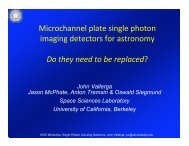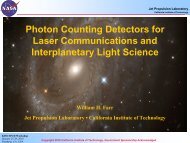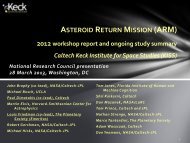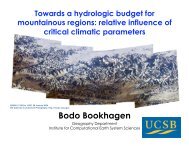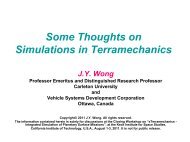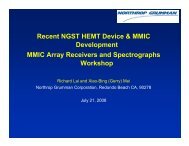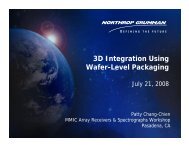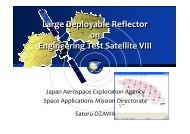Target NEO: Open Global Community NEO Workshop Report
Target NEO: Open Global Community NEO Workshop Report
Target NEO: Open Global Community NEO Workshop Report
You also want an ePaper? Increase the reach of your titles
YUMPU automatically turns print PDFs into web optimized ePapers that Google loves.
ReferencesDRAFT: RELEASED FOR PUBLIC COMMENT[1] Adamo, D. R., Giorgini, J. D., Abell, P. A., and Landis, R. R., “Asteroid Destinations Accessiblefor Human Exploration: A Preliminary Survey in Mid-2009,” Journal of Spacecraft andRockets, vol. 47, no. 6, pp. 994–1002, 2010.[2] Barbee, B. W., Esposito, T., Piñon, E. III, Hur-Diaz, S., Mink, R. G., and Adamo, D. R., “AComprehensive Ongoing Survey of the Near-Earth Asteroid Population for Human Mission Accessibility,”in Proceedings of the AIAA/AAS Guidance, Navigation, and Control Conference,(Toronto, Ontario, Canada), 2-5 August 2010. Paper 2010-8368.[3] Hopkins, J. B. and Dissel, A. F., “Plymouth Rock: An Early Human Mission to Near-EarthAsteroids Using Orion Spacecraft,” in Proceedings of the AIAA Space 2010 Conference andExposition, (Anaheim, California), 30 August - 2 September 2010. Paper 2010-8608.[4] Landau, D. and Strange, N., “Human Exploration of Near-Earth Asteroids via Solar ElectricPropulsion,” in Proceedings of the 21 st AAS/AIAA Space Flight Mechanics Meeting, (NewOrlean, Louisiana), 13-17 February 2011. Paper AAS 11-102.[5] Strange, N., et al., “Solar Electric Propulsion for a Flexible Path of Human Exploration,” inProceedings of the 61 st International Astronautical Congress, (Prague, Czech Republic), 27September - 1 October 2010. Paper IAC-10-A5.2.4.[6] Rubin, A. E., “Mineralogy of Meteorite Groups,” Meteoritics and Planetary Science, vol. 32,pp. 231–247, 1996.[7] Weisberg, M. K., McCoy, T. J., and Krot, A. N. , “Systematics and Evaluation of MeteoriteClassification,” in Meteorites and the Early Solar System II (Lauretta, D.S. and Jr., H. Y.M.,ed.), pp. 19–52, Tucson: University of Arizona Press, 2006.[8] Binzel, R. P., Rivkin, A. S., Bus, S. J., Sunshine, J. M., and Burbine, T. H., “MUSES-C <strong>Target</strong> Asteroid (25143) 1998 SF36: A Reddened Ordinary Chondrite,” Meteoritics andPlanetary Science, vol. 36, pp. 1167–1172, 2001.[9] Rivkin, A. S., Binzel, R. P., Sunshine, J., Bus, S. J., Burbine, T. H., and Saxena, A., “InfraredSpectroscopic Observations of 69230 Hermes: Possible Unweathered Endmember Among OrdinaryChondrite Analogs,” Icarus, vol. 172, pp. 408–414, 2004.[10] Binzel, R. P., Rivkin, A. S., Stuart, J. S., Harris, A. W., Bus, S. J., and Burbine, T. H.,“Observed Spectral Properties of Near-Earth Objects: Results for Population Distribution,Source Regions, and Space Weathering Processes,” Icarus, vol. 170, pp. 259–294, 2004.[11] Reddy, V., Nathues, A., and Gaffey, M. J., “First Fragment of Asteroid 4 Vesta’s MantleDetected,” Icarus, vol. 212, pp. 175–179, 2011.[12] Abell, P. A., Near-IR Reflectance Spectroscopy of Mainbelt and Near-Earth Objects: A Studyof Their Compositions, Meteorite Affinities, and Source Regions. PhD thesis, Rensselaer PolytechnicInstitute, Troy, NY, 2003.DRAFT: RELEASED FOR PUBLIC COMMENT 31




